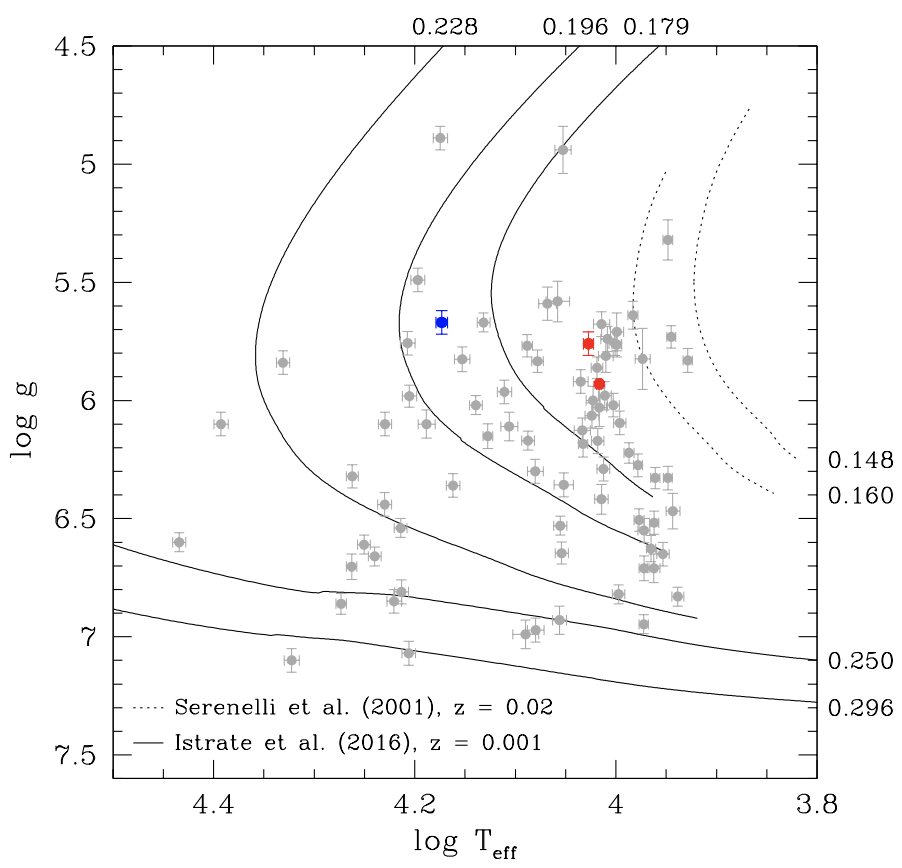Title: The closest extremely low-mass white dwarf to the Sun
Authors: Adela Kawka, Jeffrey D. Simpson, Stephane Vennes, Michael S. Bessell, Gary S. Da Costa, Anna F. Marino, Simon J. Murphy
First Author’s Institution: International Centre for Radio Astronomy Research – Curtin University, GPO Box U1987, Perth, WA 6845, Australia
Status: Accepted for publication in MNRAS Letters, open access on arXiv
More Than Just Dying Embers
Stars spend most of their lives on the main sequence, where they happily fuse hydrogen into helium in their cores. After hydrogen fusion in a star’s core stops, the star leaves the main sequence and goes through several later stages of evolution. While massive stars with M > 8 solar masses (M) die and become either neutron stars or black holes, the majority of stars in the universe lose their outer layers and become planetary nebulae. At the centers of these objects are the cores of the now-dead stars, known as white dwarfs.
White dwarfs (WDs) are interesting for several reasons. They allow us to learn about the late stages of stellar evolution, glean details on stellar populations, and even gain insight into properties of exotic matter. There is a particular class of WDs that is especially intriguing, known as extremely-low mass (ELM) WDs, whose masses are less than 0.3 M. Based on our current understanding of stellar evolution, a single star cannot create such a wimpy WD. Therefore, these ELM WDs must lose a significant amount of their mass as they age. One way this occurs is when a binary companion steals mass from them. These objects are rare (with only ~100 known) and tend to live binary systems.
Even though their parent star is dead doesn’t mean that WDs don’t have any life left in them. Since they are old stellar cores, they are extremely hot, radiating significant amounts of high-energy ultraviolet light. Over time a single WD will just cool off and fade, but if a WD has a partner, they can emit gravitational waves as they orbit each other or even explode when they get too massive (more on these later). This paper presents the confirmation of the closest yet known ELM WD and what systems like it may tell us in the future.
Making Friends
Through serendipitous observations, 2MASS J050051.85–093054.9 (or J0500−0930 for short) was confirmed to be a rare ELM WD. Using Gaia, a satellite that measures the distances to stars using parallax, the authors find that J0500−0930 is the closest ELM WD, at a distance of only 71 parsecs (about half the distance to the next closest ELM WD). Luckily, J0500−0930 happened to fall in one of the sectors for the Transiting Exoplanet Survey Satellite (TESS), which performs photometry (or measures the amount of light from a source) in 30 minute intervals. The exquisite TESS light curve is shown in Figure 1. By measuring the power at different frequencies (a power spectrum) in the TESS light curve, the authors are able to calculate a period of 9.46 hours for this object.

Figure 2 shows an independent way of measuring the period for J0500−0930. By taking spectra of the object at many different times, the authors measured the velocity of the WD through the Doppler effect. By plotting the velocities of J0500−0930 over time, they created what is called a radial velocity curve. The authors again computed a power spectrum and were able to fit for an orbital period, which is consistent with that computed from the TESS light curve.

Finally, the authors want to estimate important parameters of the WD and its atmosphere, such as the temperature and surface gravity. They do this two separate ways by fitting both the spectra and spectral energy distribution of the WD. The location of J0500−0930 in T – log(g) space as derived from these methods is shown as the red points in Fig. 3. Combining the temperature and log(g) measurements with the amplitude of the radial velocity curve, the authors were able to estimate a mass of 0.17 M, with a faint companion of M ~0.3 M
. It can be seen that in comparison to other ELM WDs, J0500−0930 is among the lowest mass ELM WDs.

Ripples on a Pond or Fireworks in the Night?
White dwarf binaries present a unique opportunity to study physics beyond just stellar evolution. As two WDs orbit around each other, they cause small ripples in spacetime, and slowly lose their energy through gravitational radiation. The Laser Interferometer Space Antenna (LISA), will find many of these systems throughout our Galaxy. This will give us valuable information on stellar populations, mass transfer, and compact binaries.
Additionally, it is known that Type Ia supernovae result from the explosion of a WD. There are two channels thought to be capable of producing such an event. First is the so-called single degenerate scenario, in which there is one WD. The second, and likely more common scenario, is the merger of two WDs (known as the double-degenerate scenario). Type Ia supernovae are crucial to our understanding of the evolution of the universe, as they are standardizable candles. Therefore, it is very important that we continue to perfect our understanding of how they actually happen.
Unfortunately, J0500−0930 and its companion WD will emit only weak gravitational waves below LISA’s detection limit. They will also not merge for over 30 billion years (well over the current age of the universe), and even then they may not be massive enough to cause a supernova. However, in order to interpret the results of missions like LISA and continue to constrain the mechanisms driving Type Ia supernovae, it is important to have similar systems where detailed and precise measurements can be made. We must therefore make friends with our neighbors like J0500−0930 where such valuable information can be learned.



